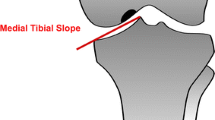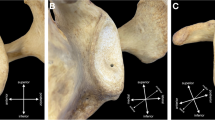Abstract
Objective
To determine if MRI (magnetic resonance imaging) of the femoral condyles in children can differentiate variations in ossification from osteochondritis dissecans (OCD).
Methods
MRI studies of the knee of 315 patients demonstrated ossification defects of the femoral condyles involving the subchondral bone plate. MRI features categorized the defects as ossification variability (N = 150) or OCD (N = 165). Both groups were compared for age, residual physeal cartilage, site, configuration, ‘lesion angle’ and associated findings.
Results
(a) Ossification variability did not occur in girls >10 year. and boys >13 year., OCD did not occur in children younger than 8 year. (b) Ossification variability was not seen in patients with 10% or less residual physeal cartilage, OCD was rare in patients with 30% or greater residual physeal cartilage. (c) Ossification variability was located in the posterior third of the femoral condyle, OCD occurred most commonly in the middle third. (d) Intracondylar extension was seen in OCD and not in ossification variability. (e) Perilesional oedema was very common with OCD and absent with ossification variability. (f) Lesion angle <105° was a feature of ossification variability.
Conclusion
MRI may help differentiate variations in ossification of the femoral condyles from OCD.










Similar content being viewed by others
References
Varich JL, Loar T, Jaramillo D (2000) Normal maturation of the distal femoral epiphyseal cartilage: age-related changes at MR imaging. Radiology 214:705–709
Loar T, Jaramillo D (2009) MR imaging insights into skeletal maturation: what is normal? Radiology 250:28–38
Gebarski K, Hernandez RJ (2005) Stage-I osteochondritis dissecans versus normal variants of ossification in the knee in children. Pediatr Radiol 35:880–886
Kijowski R, Blankenbaker DG, Shinki K, Fine JP, Graf BK, De Smet AA (2008) Juvenile versus adult osteochondritis dissecans of the knee: appropriate MR imaging criteria for instability. Radiology 248:571–578
Robertson W, Kelly BT, Green DW (2003) Osteochondritis dissecans of the knee in children. Curr Opin Pediatr 15:38–44
Bohndorf K (1998) Osteochondritis (osteochondrosis) dissecans: a review and new MRI classification. Eur Radiol 8:103–112
Cahill BR, Phillips MR, Navarro R (1989) The results of conservative management of juvenile osteochondritis dissecans using joint scintigraphy. Am J Sports Med 17:601–606
Harding WG III (1977) Diagnosis of osteochondritis dissecans of the femoral condyles. Clin Orthop Relat Res 123:25–26
Hughston JC, Hergenroeder PT, Courtenay BG (1984) Osteochondritis dissecans of the femoral condyles. J Bone Joint Surg Am 66:1340–1348
Landis JR, Koch GG (1977) The measurement of observer agreement for categorical data. Biometrics 33:159–174
Sontag LW, Pyle SI (1941) Variations in the calcification pattern in epiphyses. AJR Am J Roentgenol 45:50–54
Nawata K, Teshima R, Morio Y, Hagino H (1999) Anomalies of ossification in the posterolateral femoral condyle: assessment by MRI. Pediatr Radiol 29:781–784
Linden B (1976) The incidence of osteochondritis dissecans in the condyles of the femur. Acta Orthop Scand 47:664–667
Williams JS, Bush-Joseph CA, Bach BR (1998) Osteochondritis dissecans of the knee. Am J Knee Surg 11:221–232
Cain EL, Clancy WG (2001) Treatment algorithm for osteochondral injuries of the knee. Clin Sports Med 20:321–342
Wall EJ, Vourazeris J, Meyer GD et al (2008) The healing potential of stable juvenile osteochondritis dissecans knee lesions. J Bone Joint Surg Am 90:2655–2664
Author information
Authors and Affiliations
Corresponding author
Rights and permissions
About this article
Cite this article
Jans, L.B.O., Jaremko, J.L., Ditchfield, M. et al. MRI differentiates femoral condylar ossification evolution from osteochondritis dissecans. A new sign. Eur Radiol 21, 1170–1179 (2011). https://doi.org/10.1007/s00330-011-2058-x
Received:
Accepted:
Published:
Issue Date:
DOI: https://doi.org/10.1007/s00330-011-2058-x




